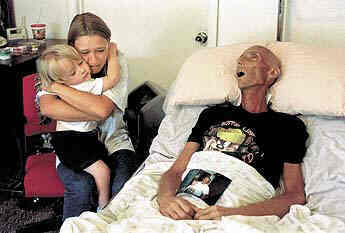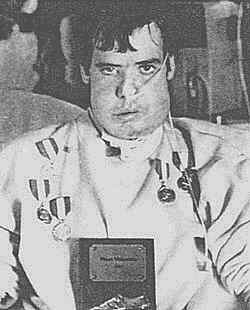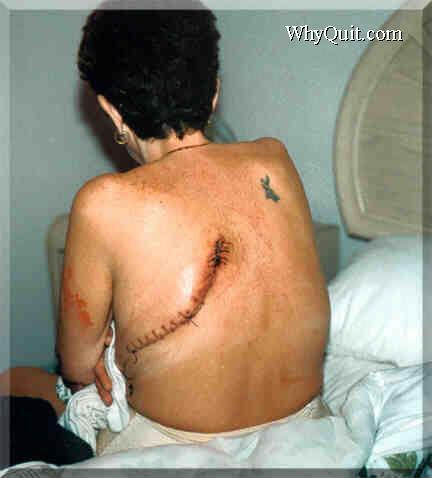
Leading quit smoking site celebrates 10th anniversary
 July 15, 1999 silently heralded birth of a free quit smoking website whose sole objective was to suggest to smokers why they might want to stop. But time and understanding have caused the Internet's #1 non-government quitting site, a commercial free forum that sells nothing, declines donations and is staffed entirely by volunteers, to increasingly focus on the root cause of dependency rather than nicotine's method of delivery.
July 15, 1999 silently heralded birth of a free quit smoking website whose sole objective was to suggest to smokers why they might want to stop. But time and understanding have caused the Internet's #1 non-government quitting site, a commercial free forum that sells nothing, declines donations and is staffed entirely by volunteers, to increasingly focus on the root cause of dependency rather than nicotine's method of delivery.
WhyQuit.com embarked dedicated to sharing the tragic story of a 34 year-old Marlboro smoker, who in just 64 days watched the most aggressive form of lung cancer, small or oat cell, shatter his  dreams, emaciate his body, claim his life and devastate his family.
dreams, emaciate his body, claim his life and devastate his family.
His name was Bryan Lee Curtis and he'd started smoking at age 13. According to his mom, his mission during his final weeks of life was to see some good flow from his tragedy. The family tried to interest local newspapers, radio and television stations in sharing his story but by the time the area's newspaper arrived, on June 3, 1999, Bryan lie dead in his bed.
Entitled "He Wanted You to Know," the St. Petersburg Times published Bryan's story on June 15, 1999. Links to the Times story quickly spread across Internet quit smoking support groups around the globe. When I clicked on the link, the contrast between his March 29 photo showing a healthy looking Bryan holding his two-year-old son Bryan Jr., and his June 3 death bed photo with his son and wife in mourning at his side, left me shocked and stunned as I sat staring with my mouth agape.
Convinced my previous 30 days of successful quitting had been the hardest thing I'd eve done, I was instantly forced to reflect on what real suffering looked like, and the consequences of defeat.
Having e-mailed and thanked Sue Landry, the story's author, I quickly found myself personally and emotionally invested in two follow-up St. Petersburg Times articles about the power of Bryan's message upon our determination to succeed ("His Message Transcends Death" and "Smokers Breathe in Support Online").
Increasingly I felt a moral obligation to ensure that Bryan's parting gift continued to transcend his death. He had refueled and rejuvenated my own personal quitting motivations, motivations strained by challenge, time and more time. It only took seconds with Bryan to feel an inspirational surge that burned into my brain the undeniable realization that the wind beneath my own recovery wings hadn't been strength or power. It was my original day #1 dreams and desires that had just been invigorated by an extremely giving person, a man I'd never meet.
 I started treating WhyQuit as a motivational pit-stop where smokers could find the inspiration to begin their journey home and quitters the fuel to get them there. But then I was shown a disturbing photo of Sean Marsee. Sean, a smokeless tobacco user since age 12 was his high school's star athlete, having amassed 28 track and field running medals. His expression, swollen face, neck bandage and a tube up his nose was haunting and in stark contrast to the smiling, dream filled face captured in his high school senior picture. Now, Sean was engaged in the most important race of his life, a race to beat mouth cancer, a race that he lost at age 19.
I started treating WhyQuit as a motivational pit-stop where smokers could find the inspiration to begin their journey home and quitters the fuel to get them there. But then I was shown a disturbing photo of Sean Marsee. Sean, a smokeless tobacco user since age 12 was his high school's star athlete, having amassed 28 track and field running medals. His expression, swollen face, neck bandage and a tube up his nose was haunting and in stark contrast to the smiling, dream filled face captured in his high school senior picture. Now, Sean was engaged in the most important race of his life, a race to beat mouth cancer, a race that he lost at age 19.
Like Bryan, Sean wanted oral tobacco users to know the potential consequences of dipping snuff. I located a copy of the Reader's Digest issue that had featured his story and presented it in a manner I hoped would do for oral tobacco users what Bryan had done for me.
On September 8, 1999 WhyQuit added its own group peer support forum when one of my quitting mentors, Joanne Diehl, joined me in opening and helping manage Freedom from Tobacco, a free MSN based messageboard. When MSN closed Groups in February of this year we moved Freedom to Yuku and took the opportunity to rename it "Freedom from Nicotine." I'm still not sure what could possibly have made us feel qualified to run a quit smoking support group, because clearly we weren't. The initial four months of our "anything goes" forum were a total disaster, as relapse was everywhere.
Joanne and I were talking about shutting Freedom down when, like a gift from God, on January 20, 2000 Joel Spitzer of Chicago arrived and saved us from ourselves. Today, Joel very likely holds the record as the most accomplished stop smoking counselor the world has ever known. He brought with him nearly 100 empowering articles he'd authored and 29 years of full-time cessation counseling experience (today 38) that included presenting more than 350 six-session, two-week stop smoking clinics and over 690 single session seminars at universities, health departments, businesses and hospitals throughout the the Metropolitan Chicago area.
Joel soon had us focusing on the root cause of Bryan's and Sean's deaths, and why nearly 40% of nicotine gum users are today hooked on the cure. We learned that nicotine enslaves the human brain in the same manner as illegal drugs, that we are in fact true drug addicts. It took a few months to fully sink in but once the group absorbed Joel's lessons, especially the "Law of Addiction," it made the rules of successful quitting surprisingly simple. Boiled down, there was really only one rule that if followed guaranteed success to all ... no nicotine today!
Joel became our director of education and we gave his articles, which we collectively named "Joel's Library," center-stage. Almost overnight, WhyQuit was transformed into the Internet's leading authority on the art, science and psychology of abrupt nicotine cessation, what we affectionately termed "educated" cold turkey quitting. There was no doubt about it, knowledge is a quitting method.
Over the years, WhyQuit would become home to Joel's free PDF quit smoking book "Never Take Another Puff," to his hundreds of video quitting lessons, including the doorway to his free Daily Quitting Lesson Guide.
 Motivation, education and support, by mid-2000 WhyQuit's menu seemed complete. But Bryan and Sean's stories not only impacted visiting students and tobacco users, it became a magnet for others, a commercial-free home to share their own frightening message, or a glimpse of the massive hole that had been left in their family's heart.
Motivation, education and support, by mid-2000 WhyQuit's menu seemed complete. But Bryan and Sean's stories not only impacted visiting students and tobacco users, it became a magnet for others, a commercial-free home to share their own frightening message, or a glimpse of the massive hole that had been left in their family's heart.
In 2002, Noni Glykos' brother John helped build Noni's page, using photographs to tell how his 32 year-old pregnant sister was diagnosed with terminal lung cancer less than 2 months after having given birth to her only child, a son. The video clip of Noni's speech at her final birthday party, knowing she had little time left to live, is heart wrenching.

Then came 44 year-old Kim Genovy who in 2002 had her left lung removed following a lung cancer diagnoses. Kim and her loving sister Kelly joined our support group, Freedom, where to this day the courage oozing from scores of old messageboard posts remind struggling quitters of the bigger and more painful battle that looms in defeat.
Kim tells her own story on a web page she entitled, "Fortunate to Be Alive to Tell About It." Unfortunately, on June 23, 2004 the entire group mourned Kim's passing as her lung cancer had traveled to her brain, requiring two attempts to remove tumors, the second of which she failed to survive.
Most recently, WhyQuit visitors have followed the two-year, stage IV lung cancer nightmare of 38 year-old Deborah Scott, on a page she entitled, "I'm Deborah and Smoking Has Smoked This Body."

Prior to her death, Deborah's 24 page Internet diary was accessed 89,521 times, nearly all by smokers and quitters. The impact of her giving is clearly evident in the more than 100 memorial diary entries, most expressing gratitude for helping empower them to avoid the possibility of a similar fate.
Over the past decade WhyQuit has added a famous victims under age 60 page and a page of motivational video clips. Physicians have joined the motivational team in sharing statements from a cardiologist, cancer radiologist and nicotine pharmacologist. Successful long-term cold turkey quitters share quitting insights and families memorialize the loss of loved ones. WhyQuit is involved in youth smoking prevention and focus upon special populations of quitters such as expectant mothers.
WhyQuit's history hasn't been without controversy. Early in 2000 Joel mentioned how he had read an early nicotine patch study that indicated use of "subtherapeutic" levels of nicotine in placebo study patches. As much as I'd come to admire Joel, I found this hard to believe.
For years, marketing had passed placebo quitters off as being the same as cold turkey quitters. But with real cold turkey quitting their bloodstream becomes 100% nicotine-free and withdrawal peaks in intensity within 72 hours. To think that researchers had teased and kept the placebo group in a near constant state of perpetual, deprived withdrawal, it was simply unthinkable.
I started digging in journals at our local medical university (MUSC). What I found was worse than imagined. Researchers were not only using small amounts of nicotine in placebo patches, the practice was widespread, some researchers were not sure if placebo patches in their study contained nicotine, there was no foundation research comparing performance of doctored to inert placebos, and the practice extended to using up to 1 mg. of nicotine as in placebo gum as a "masking" agent as early as 1982 (Jarvis 1982).
Ongoing research left me increasingly convinced that nicotine replacement therapy studies were not blind as claimed, that it was impossible to hide full-blown nicotine withdrawal from experienced quitters, that the double-blind scientific foundation of all placebo controlled quit smoking trials had been a two decade sham and farce, that was likely now starting to cost thousands their lives. Recently shared in Canada's leading medical journal, it's a sham I continue to work to expose.
By 2002 WhyQuit was the ranked second among non-government quitting sites. I wrote U.S. government health officials asking that our link be added along with other non-government smoker referral links to their websites. As featured in a February 8, 2007 Wall Street Journal article, it was then I received a written response letting me know that our site advocating abruptly ending all nicotine use, instead of replacing it, was not "science-based."
Today, U.S. government health officials continue to black list WhyQuit from serving as a quitting referral resource on any government health website. Why? Since June 2000 official U.S. cessation policy, written by an expert panel on which 11 of 17 members had pharmaceutical industry financial ties, has required that all quitters purchase and use FDA approved pharmacology products. Sadly, pharmaceutical industry muscle and sham science have effectively outlawed the quitting method responsible for generating nearly 90% of all long-term successful ex-smokers.
Frankly, that's what makes WhyQuit's continuing popularity so fascinating, that thousands of nicotine addicts still follow their natural instincts and dive into Joel's Library each and every day, when for more than a decade their government has falsely painted quitting cold turkey as nearly impossible.
Sincere thanks to the thousands who have personally contributed over the years to making WhyQuit one of the most effective nicotine dependency recovery resources ever. Millions of words at WhyQuit but still just one rule for each of us ... no nicotine today!
Breathe deep, hug hard, live long WhyQuit!

